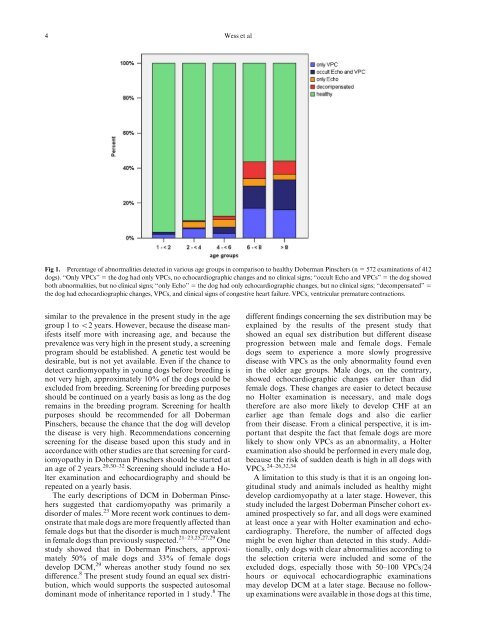Prevalence of Dilated Cardiomyopathy in Doberman Pinschers in ...
Prevalence of Dilated Cardiomyopathy in Doberman Pinschers in ...
Prevalence of Dilated Cardiomyopathy in Doberman Pinschers in ...
Create successful ePaper yourself
Turn your PDF publications into a flip-book with our unique Google optimized e-Paper software.
4 Wess et al<br />
Fig 1. Percentage <strong>of</strong> abnormalities detected <strong>in</strong> various age groups <strong>in</strong> comparison to healthy <strong>Doberman</strong> P<strong>in</strong>schers (n 5 572 exam<strong>in</strong>ations <strong>of</strong> 412<br />
dogs). ‘‘Only VPCs’’ 5 the dog had only VPCs, no echocardiographic changes and no cl<strong>in</strong>ical signs; ‘‘occult Echo and VPCs’’ 5 the dog showed<br />
both abnormalities, but no cl<strong>in</strong>ical signs; ‘‘only Echo’’ 5 the dog had only echocardiographic changes, but no cl<strong>in</strong>ical signs; ‘‘decompensated’’ 5<br />
the dog had echocardiographic changes, VPCs, and cl<strong>in</strong>ical signs <strong>of</strong> congestive heart failure. VPCs, ventricular premature contractions.<br />
similar to the prevalence <strong>in</strong> the present study <strong>in</strong> the age<br />
group 1 to o2 years. However, because the disease manifests<br />
itself more with <strong>in</strong>creas<strong>in</strong>g age, and because the<br />
prevalence was very high <strong>in</strong> the present study, a screen<strong>in</strong>g<br />
program should be established. A genetic test would be<br />
desirable, but is not yet available. Even if the chance to<br />
detect cardiomyopathy <strong>in</strong> young dogs before breed<strong>in</strong>g is<br />
not very high, approximately 10% <strong>of</strong> the dogs could be<br />
excluded from breed<strong>in</strong>g. Screen<strong>in</strong>g for breed<strong>in</strong>g purposes<br />
should be cont<strong>in</strong>ued on a yearly basis as long as the dog<br />
rema<strong>in</strong>s <strong>in</strong> the breed<strong>in</strong>g program. Screen<strong>in</strong>g for health<br />
purposes should be recommended for all <strong>Doberman</strong><br />
P<strong>in</strong>schers, because the chance that the dog will develop<br />
the disease is very high. Recommendations concern<strong>in</strong>g<br />
screen<strong>in</strong>g for the disease based upon this study and <strong>in</strong><br />
accordance with other studies are that screen<strong>in</strong>g for cardiomyopathy<br />
<strong>in</strong> <strong>Doberman</strong> P<strong>in</strong>schers should be started at<br />
an age <strong>of</strong> 2 years. 20,30–32 Screen<strong>in</strong>g should <strong>in</strong>clude a Holter<br />
exam<strong>in</strong>ation and echocardiography and should be<br />
repeated on a yearly basis.<br />
The early descriptions <strong>of</strong> DCM <strong>in</strong> <strong>Doberman</strong> P<strong>in</strong>schers<br />
suggested that cardiomyopathy was primarily a<br />
disorder <strong>of</strong> males. 23 More recent work cont<strong>in</strong>ues to demonstrate<br />
that male dogs are more frequently affected than<br />
female dogs but that the disorder is much more prevalent<br />
<strong>in</strong> female dogs than previously suspected. 21–23,25,27,29 One<br />
study showed that <strong>in</strong> <strong>Doberman</strong> P<strong>in</strong>schers, approximately<br />
50% <strong>of</strong> male dogs and 33% <strong>of</strong> female dogs<br />
develop DCM, 29 whereas another study found no sex<br />
difference. 8 The present study found an equal sex distribution,<br />
which would supports the suspected autosomal<br />
dom<strong>in</strong>ant mode <strong>of</strong> <strong>in</strong>heritance reported <strong>in</strong> 1 study. 8 The<br />
different f<strong>in</strong>d<strong>in</strong>gs concern<strong>in</strong>g the sex distribution may be<br />
expla<strong>in</strong>ed by the results <strong>of</strong> the present study that<br />
showed an equal sex distribution but different disease<br />
progression between male and female dogs. Female<br />
dogs seem to experience a more slowly progressive<br />
disease with VPCs as the only abnormality found even<br />
<strong>in</strong> the older age groups. Male dogs, on the contrary,<br />
showed echocardiographic changes earlier than did<br />
female dogs. These changes are easier to detect because<br />
no Holter exam<strong>in</strong>ation is necessary, and male dogs<br />
therefore are also more likely to develop CHF at an<br />
earlier age than female dogs and also die earlier<br />
from their disease. From a cl<strong>in</strong>ical perspective, it is important<br />
that despite the fact that female dogs are more<br />
likely to show only VPCs as an abnormality, a Holter<br />
exam<strong>in</strong>ation also should be performed <strong>in</strong> every male dog,<br />
because the risk <strong>of</strong> sudden death is high <strong>in</strong> all dogs with<br />
VPCs. 24–26,32,34<br />
A limitation to this study is that it is an ongo<strong>in</strong>g longitud<strong>in</strong>al<br />
study and animals <strong>in</strong>cluded as healthy might<br />
develop cardiomyopathy at a later stage. However, this<br />
study <strong>in</strong>cluded the largest <strong>Doberman</strong> P<strong>in</strong>scher cohort exam<strong>in</strong>ed<br />
prospectively so far, and all dogs were exam<strong>in</strong>ed<br />
at least once a year with Holter exam<strong>in</strong>ation and echocardiography.<br />
Therefore, the number <strong>of</strong> affected dogs<br />
might be even higher than detected <strong>in</strong> this study. Additionally,<br />
only dogs with clear abnormalities accord<strong>in</strong>g to<br />
the selection criteria were <strong>in</strong>cluded and some <strong>of</strong> the<br />
excluded dogs, especially those with 50–100 VPCs/24<br />
hours or equivocal echocardiographic exam<strong>in</strong>ations<br />
may develop DCM at a later stage. Because no followup<br />
exam<strong>in</strong>ations were available <strong>in</strong> those dogs at this time,






